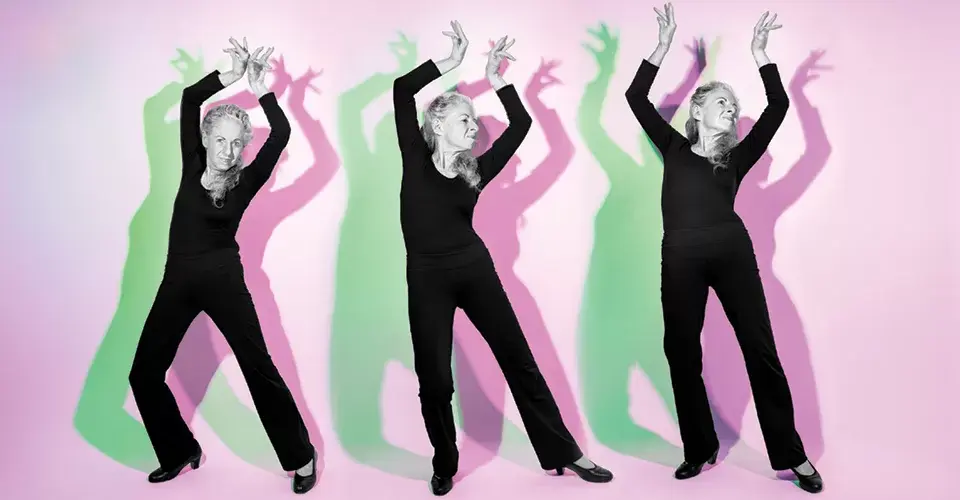Pole Positions
Researcher Takes Strong Stances on Commonalities Between Ballet, Hip-hop and Exotic Dancing
by Chris Carroll | Photo Illustration by John T. Consoli and Stephanie S. CordleTerp can’t say for sure that Judith Lynne Hanna, a research professor in anthropology, is the only University of Maryland faculty member to dance the head-banging lead role in a punk band’s music video this year. But we are certain she was the only one in her 80s to do so. It wasn’t an extreme stretch for Hanna, who has researched dance as a means of communication since the 1960s and has been a dancer herself for more than 70 years, and still attends dance class almost daily. From ritual communal dances to ballet to exotic dance (Hanna is a vocal defender of strippers), she considers all of it a language layered with cultural meaning and aesthetic values. She recently sat down to discuss her decades studying dance as human behavior—in all its forms.
You spoke up for Stormy Daniels in the media earlier this year when she danced at a strip club in Baltimore. Why?
I defend exotic dancers because they are under the umbrella of the First Amendment. Since 1995, I’ve worked as an expert witness on 134 cases involving exotic dance with 64 different lawyers from coast to coast. There’s something about a woman going out of her home in the public arena, showing her body and making money that threatens some people. But since the 1960s, we’ve had [modern dance icon] Bill T. Jones with 50 nude people on stage at the Kennedy Center, and no one thinks that’s a big deal.
Is there a difference between “serious” forms of dance that include nudity, and ones designed to stimulate the male libido?
It’s all in the eyes of the beholder. Women now also go to strip clubs. Nudity is not just eroticism—it’s the natural body, God’s gift to humanity. It’s an art in motion, a challenge to the pretense of clothing, and freedom from arbitrary social conventions. One of the things that I do when I talk about nudity in adult entertainment is to point out how nudity is used in opera, theater and concert dance.
What’s the current state of dance in America?
The rise of macho hip-hop has made it more acceptable for boys to dance. When I was raising my sons, they’d ask, “What do you do in jazz class?” But I could never get them to even observe. Now, fathers are more receptive to their sons dancing. There has been this idea that males who dance must be “sissies” or gay. Also, reality-TV dance competitions have created wider interest in dance.
What came first: your love of dancing, or an interest in it as a scholarly subject?
My love of dance came first. I had flat feet and when I was 8, the pediatrician in St. Louis told my mother it would make my feet strong. I started with ballet. Then we moved to California where I discovered modern dance, and I went to UC Berkeley and explored Afro-Caribbean dance. I just kept trying different forms. Dance didn’t help my feet, but I was hooked.
What has your research centered on?
My original research as an anthropologist started in Nigeria among the Igbo people. I learned that dance was a very powerful medium of communication, politics and education. My first book, published in 1979, was criticized because I was saying that dance is a language and is comparable to verbal language. In the past 15 years new technology has allowed neuroscientists to study dancers’ brains while they move, and it turns out my theory has had some empirical validation. I am now exploring dance and the brain—cognition, emotion and movement in learning.
Any wellness tips for the rest of us who might be interested in being able to cut a rug into our 80s?
You find something physical that you like to do, and try it, and if you haven’t been active, be careful and don’t overdo it—but do it. Dance is wonderful when you are older; we once thought older people simply lost brain cells as they aged, but neuroscience has found that dance as exercise helps create new cells and connections. And there’s also the aspect of dance as communication, which is important for not being lonely—if you go to a dance studio or a salsa dancing class, you can’t avoid being with others.
So how did you end up in that music video?
It’s a first for me. The producer [working with female-fronted punk band Egg Drop Soup] learned about me through my 13-year-old grandson, Merrick Hanna. He’s a professional hip-hop dancer who was on “America’s Got Talent” and in other venues. Being in a music video sounded fun, so I flew to California to dance in it.
Watch a video of Hanna dancing with her grandson here.
0 Comments
Leave a Reply
* indicates a required field

